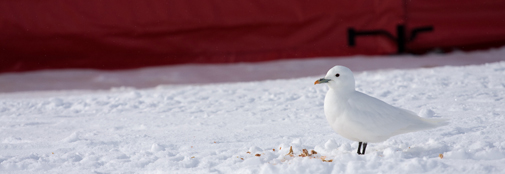NEEM animal life

NEEM bird of the day: Pagophilia Eburnean .
Today we had for the first time in more than a week a visitor in camp: a Pagohpilia eburnean (see picture) that normally spends its time in selected areas at the coast. On arrival, the bird was served bread crumbs and mackerel in tomato sauce that it ate immediately. We are, however, concerned about the future of our visitor. The smaller birds that arrived to camp, unfortunately, all left in ice core boxes marked Keep Frozen. Larger birds, such as geese, are frequently seen from camp crossing the ice sheet either alone or in groups. So far, we have not had a visit of a polar bear and we certainly do not expect to get one. With more than 300 km to the nearest coastline chances are fortunately extremely low. Someone might claim that the Homo sapiens at NEEM do start to show animal-like behavior after spending some time in the field, but that is a different story.
What we have done today:
- Drilling with the NEEM long drill: 34 m. Drillers depth: 796 m.
- Ice core processing: 21.45 m. Depth: 506.00 m.
- CFA analysis: 24.75 m. Depth: 189.75 m.
- Finishing BAS radar program.
- Calibrated Picarro water isotope instrument.
- Seismic station checked and calibrated.
- Boosting drill trench cooling tunnel with additional blower.
"Today we drilled 25.82 m of ice core finishing at 762 m depth. Maintenance was required on the drill when the plastic electrical connections plate cracked in the anti-torque section, leaving a piece of plastic down hole but which was later successfully fished out. A new plate was made from similar plastic material by Philippe (with eager helpers) and this was fitted and drilling continued."
Ad. 2: Processing close-to-brittle-zone-ice requires a lot of patience. Mai Winstrup keeps the Swiss saw running at lowest possible speed whereby the number of breaks in the cores is minimized.
Ad. 5: The Picarro water isotope instrument is installed in an insulated box on top of the CFA hut that provides a continuous melt water stream from the CFA melt head. We are excited about this first successful calibration because this type of instrument potentially may be able to provide continuous on-line ice-core water-isotope profiles in the future. We do, however, keep our expectations low for this first test season of the new instrument.
Weather: Change from clear sky to thin overcast in the evening, temperatures from -9 to -14 °C, almost no wind.
Field Leader, Anders Svensson
| ← Previous entry | Next entry → |

